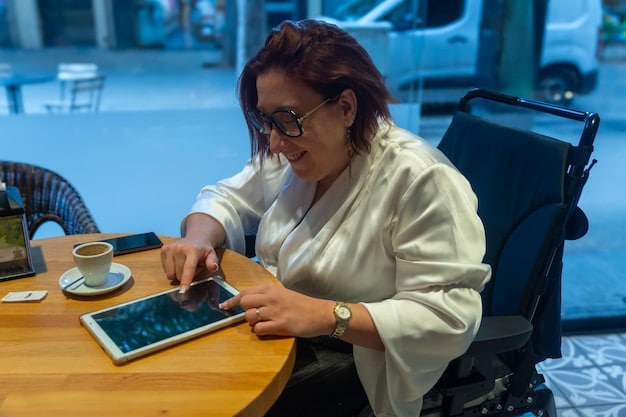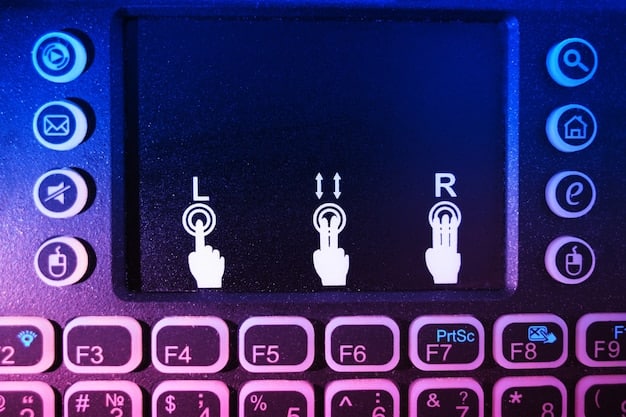Assistive Technology: 7 Devices for Independent Living

Assistive technology for special needs encompasses a variety of devices that enhance independence, ranging from communication aids to mobility solutions, empowering individuals to participate more fully in daily life.
Assistive technology for special needs can significantly improve the quality of life for individuals with disabilities, fostering greater independence and participation in various activities. These devices encompass a wide range of tools, from simple aids to sophisticated technological solutions, tailored to meet specific needs and challenges.
Understanding Assistive Technology for Special Needs
Assistive technology (AT) is a broad term that includes any device, piece of equipment, or system used to improve the functional capabilities of individuals with disabilities. It can range from low-tech solutions like pencil grips to high-tech options like speech-generating devices.
The goal of assistive technology is to enable people with special needs to participate more fully in activities they might otherwise find difficult or impossible. Let’s explore some key aspects of AT.
Types of Assistive Technology
Assistive technology can be categorized in a few different ways, based on the function it supports or the type of device it is. These categories include:
- Mobility aids: Wheelchairs, walkers, and adapted vehicles.
- Communication aids: Speech-generating devices and augmentative communication systems.
- Cognitive aids: Software and apps that help with memory, organization, and attention.
- Vision and hearing aids: Screen readers, magnifiers, and hearing aids.
Each type of assistive technology addresses different needs and challenges, helping individuals live more independently and participate actively in their communities.
Assistive technology plays a vital role in enhancing the lives of individuals with disabilities by fostering independence and access. It encompasses a variety of tools and devices tailored to individual needs, thereby improving overall well-being and participation in daily activities.
Communication Devices: Amplifying Voices
For individuals with speech impairments or communication difficulties, assistive technology can be life-changing. These devices help people express themselves, connect with others, and participate in conversations.
Communication devices come in various forms, each designed to meet specific needs and preferences. Here are a few examples:
Speech-Generating Devices (SGDs)
SGDs, also known as voice output communication aids (VOCAs), enable users to communicate by selecting words, phrases, or symbols that are then spoken aloud by the device. These devices can be controlled by touch, switch, eye gaze, or head tracking.
Communication Apps
Many apps are available for smartphones and tablets that offer similar functionality to SGDs. These apps often include customizable vocabularies, text-to-speech capabilities, and symbol libraries.

Effective communication is paramount for individuals with speech impairments. Assistive technology devices provide a vital means for expressing thoughts and needs, thereby promoting autonomy and confidence in daily interactions.
Mobility Aids: Enhancing Movement
Mobility aids are designed to help individuals with physical disabilities move more easily and safely. These devices can range from manual wheelchairs to powered mobility scooters.
The right mobility aid can significantly improve a person’s independence and quality of life, allowing them to participate in more activities and access more places.
Wheelchairs
Wheelchairs are a common type of mobility aid, available in both manual and powered versions. Manual wheelchairs require the user to propel themselves, while powered wheelchairs use batteries and motors for propulsion.
Walkers and Rollators
Walkers and rollators provide support and stability for individuals who have difficulty walking. Walkers typically have four legs and require the user to lift and move the device with each step. Rollators have wheels and brakes, allowing for smoother movement.
Mobility aids are essential for individuals with physical disabilities, offering them the freedom to navigate their environment comfortably and safely. By enhancing movement, these devices foster greater independence and participation in social activities.
Sensory Aids: Supporting Vision and Hearing
Assistive technology can also help individuals with vision or hearing impairments. Sensory aids are designed to enhance or replace lost sensory input, allowing users to access information and communicate more effectively.
From screen readers to hearing aids, these devices can make a significant difference in a person’s ability to participate in daily life.
- Screen readers: Software that converts text on a computer screen into synthesized speech or Braille.
- Hearing aids: Small electronic devices that amplify sound for individuals with hearing loss.
- Magnifiers: Devices that enlarge text or images for individuals with low vision.
Sensory aids play a critical role in assisting individuals with vision and hearing impairments by enhancing or substituting for lost sensory input. These devices facilitate access to information and improve communication, thereby enabling users to participate more fully in everyday life.
Environmental Control Systems: Managing Surroundings
Environmental control systems (ECS) allow individuals with limited mobility to control various aspects of their environment, such as lights, appliances, and doors.
These systems use a variety of input methods, such as voice commands, switches, and eye tracking, to give users greater control over their surroundings.
Voice-Activated Systems
Voice-activated systems allow users to control devices and appliances using spoken commands. These systems can be integrated with smart home technology to provide comprehensive environmental control.
Switch-Activated Systems
Switch-activated systems use a variety of switches, such as button switches, sip-and-puff switches, and head switches, to control devices and appliances. These systems are often used by individuals with severe motor impairments.

Environmental control systems empower individuals with limited mobility to manage their surroundings effectively. By providing control over lights, appliances, and other environmental factors, these systems facilitate greater independence and comfort in daily living.
Computer Access Aids: Enabling Digital Engagement
Computer access aids help individuals with disabilities use computers and other digital devices more effectively. These devices can range from alternative keyboards and mice to specialized software.
With the right computer access aid, individuals with disabilities can participate in education, work, and social activities in the digital world.
- Alternative keyboards: Keyboards with larger keys, key guards, or alternative layouts.
- Adapted mice: Mice that can be controlled with a joystick, trackball, or head movements.
- On-screen keyboards: Software that displays a keyboard on the computer screen, allowing users to type with a mouse or other pointing device.
Computer access aids play a crucial role in enabling individuals with disabilities to engage with digital devices effectively. By offering alternative keyboards, adapted mice, and specialized software, these tools facilitate participation in education, work, and social activities within the digital realm.
Daily Living Aids: Simplifying Tasks
Daily living aids are tools and devices that help individuals with disabilities perform everyday tasks more easily. These aids can range from simple utensils to specialized equipment.
By simplifying tasks like eating, dressing, and grooming, daily living aids can help individuals maintain their independence and dignity.
Adaptive Utensils
Adaptive utensils have built-up handles, angled designs, or other features that make them easier to grip and use. These utensils can help individuals with arthritis, tremors, or other motor impairments eat more independently.
Dressing Aids
Dressing aids include button hooks, zipper pulls, and sock aids that make it easier for individuals with limited mobility or dexterity to dress themselves.
Daily living aids simplify everyday tasks for individuals with disabilities, fostering independence and dignity. These tools include adaptive utensils, dressing aids, and other specialized equipment designed to make daily routines more manageable.
Cognitive Aids: Supporting Memory and Focus
Cognitive aids are tools and strategies that help individuals with cognitive impairments, such as memory loss, attention deficits, or executive function difficulties.
These aids can range from simple checklists and calendars to sophisticated software and apps that provide reminders, prompts, and organizational support.
- Reminder apps: Apps that send reminders for appointments, medications, and other important tasks.
- Organizational software: Software that helps users manage their schedules, tasks, and documents.
- Memory aids: Devices that record and play back reminders, instructions, and other important information.
Cognitive aids provide crucial support for individuals with cognitive impairments, enhancing memory and focus. Through reminder apps, organizational software, and memory aids, these tools facilitate improved cognitive function and daily task management.
| Key Point | Brief Description |
|---|---|
| 🗣️ Communication Devices | Amplify voices with speech-generating devices and apps. |
| 🚶 Mobility Aids | Enhance movement using wheelchairs and walkers. |
| 👂 Sensory Aids | Support vision and hearing with screen readers and hearing aids. |
| 🧠 Cognitive Aids | Improve memory and focus with reminder apps and software. |
Frequently Asked Questions
▼
Assistive technology includes any device or system that helps individuals with disabilities perform tasks they might otherwise struggle with. It enhances independence and quality of life.
▼
By providing tools to overcome challenges, assistive technology enables individuals to perform tasks independently. This reduces reliance on others and promotes self-sufficiency.
▼
Examples include speech-generating devices (SGDs) and communication apps on tablets or smartphones. These tools help individuals express themselves effectively.
▼
Mobility aids like wheelchairs and walkers provide support and stability, helping individuals move more easily and safely. This allows for greater participation in activities.
▼
Cognitive aids support memory, focus, and organizational skills through apps, software, and devices. They assist individuals with cognitive impairments manage daily tasks.
Conclusion
Assistive technology for special needs offers a wealth of possibilities for enhancing independence and improving the quality of life for individuals with disabilities. By understanding the various types of assistive technology available and how they can be tailored to meet specific needs, we can create a more inclusive and accessible world for everyone.





